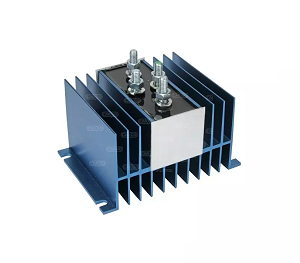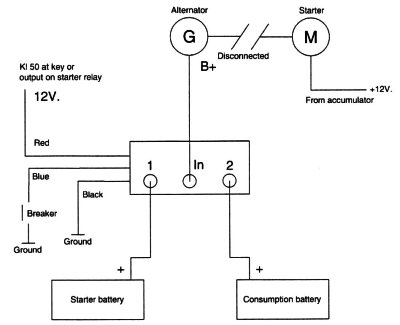
Charge the starter motor battery and the light mains battery simultaneously without being connected. Yes, that is possible!
You spent all day on the water and have made good use of all the conveniences the boat has to offer. The fridge is running, the lights are on, and you have had a good night’s sleep. The following morning, when you are about to set off for your next destination, you turn the ignition lock to start the engine, but then…
The familiar sound of a failing starter motor due to insufficient voltage. Sufficient power for lights and accessories is one of the first requirements when you venture on a long trip. But sufficient power is also needed to start the engine the next day.
Because the power requirements of the mains and the starting system are different, the best way to solve this problem is to use two separate batteries that suit the individual systems. The problem is caused by the fact that the mains is often used for a longer period of time and the starting system requires only a short jolt of power. Special start and traction accumulators are available for this purpose.
Even for smaller installations is the use of a separate light and start battery system recommended. While using power from the light battery, there is no connection with the start battery. The latter is therefore always fully charged and remains available for starting the engine. After which the batteries can be recharged by the generator of the engine.
After separating both power sources, they should also be charged separately.
 After separating both power sources, they should also be charged separately.
After separating both power sources, they should also be charged separately.
To separate the batteries and charge them with the engine generator, use a battery separator, also called a diode bridge, to distribute the output voltage among the two batteries. Alternatively, use a separator relay that switches to the second battery when the first one is fully charged. Both parts can be found here.
A battery separator is a specially manufactured diode bridge that connects the second battery (the light battery) to the alternator while the engine is running. The relay is controlled by the so-called “D+” connection of the alternator and has a provision to prevent overloading of the alternator and the charge regulator.
A choice to make: battery separator or diode bridge?
The main advantage of a battery separator is the outright separation of the battery sets under all circumstances, so if one battery is flat, it can never draw current from the other battery. Think of two barrels of water. A separator conducts the charging current from the alternator or battery charger and distributes it to the battery sets. This is done through two or more diodes, which act like a “non-return valve” for the charging current: there is only one flow direction for the current; it cannot flow back.We carry a range of simple battery separators to set up a system as described. Always remember the voltage and required power that may run over the relay.
Rule of thumb is as follows:
70 AMPERE DIODE BRIDGE: for chargers and alternators up to 55 Amps maximum charging current.
120 AMPERE DIODE BRIDGE: for chargers and alternators from 60 to 90 Amps.
150 AMPERE DIODE BRIDGE: for chargers and alternators from 100 to 120 Amps
Please keep in mind that a diode always has a bridging voltage (threshold voltage) of 0.6 volt.  It means that when using a 14V charging system, no more than 13.4 volts will run to the battery. This may cause a problem for older alternators. A separator fitted with a compensation diode prevents a voltage drop over the diode, so that the battery is charged with the correct voltage.
It means that when using a 14V charging system, no more than 13.4 volts will run to the battery. This may cause a problem for older alternators. A separator fitted with a compensation diode prevents a voltage drop over the diode, so that the battery is charged with the correct voltage.
A battery separator will still allow charging the battery, even with a charger from the general 230V power mains. See the diagram for a simple set-up of a battery separator.
Take a quick look at a low-cost battery separator for your boat!













Thanks Abmarineservice,
For sharing this method and knowledge. Now we will do the party all night without fear of battery discharge. Thanks again.